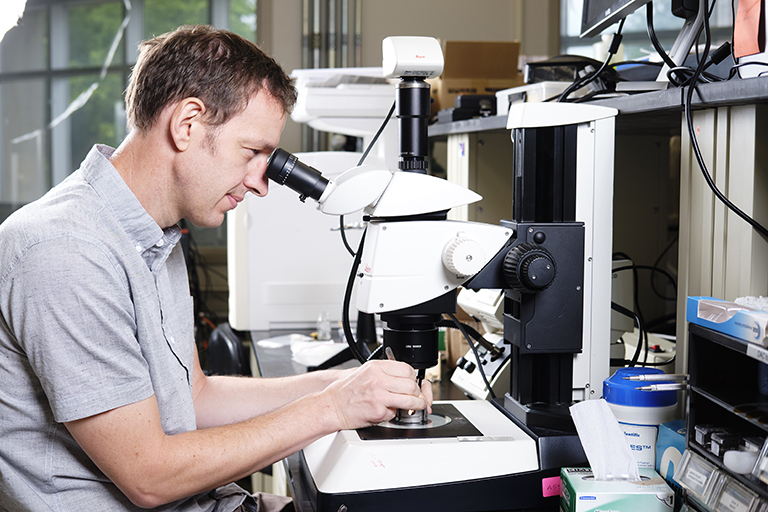Maik Lang is using neutrons to help gain a better understanding of materials.

Photo by Shawn Poynter.
Highlights
- Pyrochlores are oxides with several energy-related applications (e.g., nuclear waste containment and solid oxide electrolytes).
- Lang is using neutron scattering to discover new fundamental properties of disordered pyrochlore.
- ORNL’s Spallation Neutron Source helped characterize and observe their properties.
Although Associate Professor Maik Lang is a faculty member in the nuclear engineering department, he’s not technically an engineer; instead, he’s a physicist concerned with the fundamental behavior of materials when placed under extreme conditions, especially materials with a wide range of applications.
Lang uses structural characterization involving microscopy, spectroscopy, and scattering techniques to identify why materials exhibit certain properties and behaviors. Understanding how a material functions in harsh environments through atomic-scale techniques—that can view placements of individual atoms and chemical bonds—can have great implication when scaled up to the macro level and real-world applications.
One material class Lang is concerned with is pyrochlore—complex oxides with many technological applications. These ceramics have been frequently studied over the past 30 years, particularly in regard to what happens to their structural properties when exposed to ion irradiation or high temperatures that can render them defective. They have been less studied by neutron characterization, and, prior to Lang’s work, no one had yet used this technique for ion-irradiated materials.
In the atomic world, neutrons’ neutral charge and interaction, which is based on strong force–one of the four fundamental forces in nature—and allows them to be focused at a material’s atomic nuclei without bouncing off electrons the way X-ray probes do. This behavior also enables them to provide information on the position of light elements in a material, such as oxygen, which would be mostly invisible to X-rays due to their small number of electrons.
Lang’s proximity to the Spallation Neutron Source (SNS) at ORNL, the most intense pulsed neutron source in the world, allowed him to conduct experiments to see if neutron scattering in particular could provide new insight into defective and disordered pyrochlores.
—Maik Lang
To produce sufficient irradiated material for the SNS, Lang used one of the largest ion accelerator facilities in the world, the GSI ion-beam laboratory in Darmstadt, Germany, where he spent time during his doctoral research.
The particles accelerated inside the very large accelerators of GSI are so energetic that they move at about 15 percent of the speed of light and can penetrate deep into a material—enough for about 0.1 gram of damaged material to be obtained, which is just about enough to generate valid data from Lang’s experiments at the SNS.
Previously, researchers thought disordered materials had very random placements of atoms, but through working with GSI and SNS, Lang and his students found something different.
“When we looked with neutrons instead of X-rays and applied the total scattering approach, we found a high degree of atomic order at a local level in materials that appear to be completely disordered and random,” Lang said.
This discovery provides a new understanding of the order-to-disorder transformations in pyrochlore that are used for plutonium immobilization (host materials for nuclear waste containment), fast ion conduction (solid oxide fuel cells), and thermal barrier coatings (gas turbine jet engines).
The team’s findings also confirmed that traditional characterization techniques for pyrochlore do not paint a complete picture of their properties and behavior.
“Even if a pyrochlore is exposed to intense ion irradiation for a long time, which destroy the crystalline lattice, there will be always some level of order that remains. More important than showing that such an ordered pattern of atoms exist in disordered pyrochlore is to understand why nature in fact does this.”
Lang’s team has also demonstrated the same behavior in other ceramics such as spinel, which he said points to a more general phenomenon. His team recently received $600k in research funding from the Department of Energy to continue deepening this new understanding of the nature of disorder in pyrochlore.
Contact
Élan Young: elan@tennessee.edu